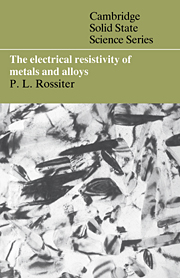Book contents
- Frontmatter
- Contents
- Preface
- 1 Basic concepts
- 2 Atomic configuration of an alloy
- 3 The structure of magnetic materials
- 4 Electrons in simple metals and alloys
- 5 Electrical resistivity of simple metals and alloys
- 6 Non-simple, non-magnetic metals and alloys
- 7 Magnetic and nearly magnetic alloys
- 8 Other phenomena
- Appendices
- References
- Index
2 - Atomic configuration of an alloy
Published online by Cambridge University Press: 07 January 2010
- Frontmatter
- Contents
- Preface
- 1 Basic concepts
- 2 Atomic configuration of an alloy
- 3 The structure of magnetic materials
- 4 Electrons in simple metals and alloys
- 5 Electrical resistivity of simple metals and alloys
- 6 Non-simple, non-magnetic metals and alloys
- 7 Magnetic and nearly magnetic alloys
- 8 Other phenomena
- Appendices
- References
- Index
Summary
In order to proceed with calculation of the electrical resistivity of a concentrated alloy it is necessary to find some suitable description of the atomic configuration.
Dilute and concentrated alloys
We start by defining a dilute alloy as one in which the solute atoms are in sufficiently small concentration that they have no effect on the electronic structure or phonon spectrum of the bulk alloy, although localised perturbations may result. In this regime the impurity atoms will act as independent scattering centres for the conduction electrons so that the effect of N impurity atoms is just N times that of a single impurity. This will only be possible if the solute atoms are widely separated (and hence randomly distributed), implying no direct or indirect interaction between them. In real alloys this composition range is usually restricted to less than 1 or 2 % solute concentration.
At higher solute concentrations the electronic structure or phonon spectrum of the bulk alloy will start to suffer perturbations, and the solute atoms may no longer be randomly distributed. Such alloys will be described as concentrated alloys and are the main concern of this text.
- Type
- Chapter
- Information
- The Electrical Resistivity of Metals and Alloys , pp. 30 - 75Publisher: Cambridge University PressPrint publication year: 1987



